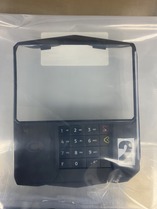
KEYPAD OVERLAY SKIMMERS
Skimming involves the installation of a device, usually undetected by customers, that secretly records bank account data when the customer inserts or swipes their credit or ATM card into the machine.
A keypad overlay such as the one featured is placed directly on top of the factory installed keypad and stores the actual keystrokes of the customers PIN. Therefore, no concealed camera is needed and allows the criminal to install these devices in a matter of seconds.
Most skimming devices are installed for short periods of time, often for a few hours and typically are attached only with double-sided tape. They are then removed by criminals who download the stolen account information and can encode it on to blank cards, make fraudulent purchases online or sell the stolen information on the internet.
HOW TO HELP AVOID BEING SKIMMED:
- Inspect the card reader or keypad before using it. Try to wiggle or gently pull up on the keypad before inserting your card to see if it has any moving parts. If it moves, don't use it.
- Keep an eye out for anything unusual, including ATMs and payment terminals that look like they have been tampered with. If the equipment seems crooked or out of place, don't use it.
- Cover the keypad when you enter your PIN to prevent any cameras from recording you.
- Use a contactless credit or debit card and simply tap it to the machine instead of inserting or swiping it.
Tips: Often times fraudulent charges on a credit card are easier to dispute than charges made using a debit card. Therefore, opt to use your credit card instead of your debit card if you have the option.
Regularly monitor credit card and ATM transactions and set up account alerts to help you detect suspicious activity.
In the event your account has been compromised, report it to your financial institution right away and make a report with the Police Department.
|